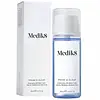What's inside
What's inside
 Key Ingredients
Key Ingredients

 Benefits
Benefits

 Concerns
Concerns

 Ingredients Side-by-side
Ingredients Side-by-side

Water
Skin ConditioningPropanediol
SolventGlycereth-26
HumectantSalicylic Acid
MaskingTranexamic Acid
AstringentDimethyl Isosorbide
SolventCyclodextrin
AbsorbentAloe Barbadensis Leaf Juice
Skin ConditioningSaccharomyces Ferment Filtrate
HumectantLecithin
EmollientOryza Sativa Lees Extract
Skin ConditioningXanthan Gum
EmulsifyingEthylhexylglycerin
Skin ConditioningButylene Glycol
HumectantSclerotium Gum
Emulsion Stabilising1,2-Hexanediol
Skin ConditioningPullulan
Disodium EDTA
Sodium Hydroxide
BufferingPolyacrylate Crosspolymer-6
Emulsion StabilisingPhenoxyethanol
PreservativeButeth-3
SolventHydroxyacetophenone
AntioxidantSodium Metabisulfite
AntioxidantSodium Benzotriazolyl Butylphenol Sulfonate
UV AbsorberTributyl Citrate
SolventPotassium Sorbate
PreservativeSilica
AbrasiveSodium Benzoate
MaskingCitric Acid
BufferingWater, Propanediol, Glycereth-26, Salicylic Acid, Tranexamic Acid, Dimethyl Isosorbide, Cyclodextrin, Aloe Barbadensis Leaf Juice, Saccharomyces Ferment Filtrate, Lecithin, Oryza Sativa Lees Extract, Xanthan Gum, Ethylhexylglycerin, Butylene Glycol, Sclerotium Gum, 1,2-Hexanediol, Pullulan, Disodium EDTA, Sodium Hydroxide, Polyacrylate Crosspolymer-6, Phenoxyethanol, Buteth-3, Hydroxyacetophenone, Sodium Metabisulfite, Sodium Benzotriazolyl Butylphenol Sulfonate, Tributyl Citrate, Potassium Sorbate, Silica, Sodium Benzoate, Citric Acid
Water
Skin ConditioningGlycerin
HumectantPropanediol
SolventSalicylic Acid
MaskingNiacinamide
SmoothingPanthenol
Skin ConditioningOryza Sativa Bran Extract
Skin ConditioningBoswellia Serrata Extract
Skin ConditioningBackhousia Citriodora Leaf Extract
AstringentMel Extract
MoisturisingOligopeptide-10
AntimicrobialBenzyl Alcohol
PerfumingPPG-26-Buteth-26
Skin ConditioningButylene Glycol
HumectantCaprylhydroxamic Acid
PEG-40 Hydrogenated Castor Oil
EmulsifyingCitric Acid
BufferingTrisodium Ethylenediamine Disuccinate
Polydextrose
HumectantDextrin
AbsorbentAmylopectin
Phenoxyethanol
PreservativeSodium Benzoate
MaskingPolylysine
Water, Glycerin, Propanediol, Salicylic Acid, Niacinamide, Panthenol, Oryza Sativa Bran Extract, Boswellia Serrata Extract, Backhousia Citriodora Leaf Extract, Mel Extract, Oligopeptide-10, Benzyl Alcohol, PPG-26-Buteth-26, Butylene Glycol, Caprylhydroxamic Acid, PEG-40 Hydrogenated Castor Oil, Citric Acid, Trisodium Ethylenediamine Disuccinate, Polydextrose, Dextrin, Amylopectin, Phenoxyethanol, Sodium Benzoate, Polylysine
 Reviews
Reviews

Ingredients Explained
These ingredients are found in both products.
Ingredients higher up in an ingredient list are typically present in a larger amount.
Butylene Glycol (or BG) is used within cosmetic products for a few different reasons:
Overall, Butylene Glycol is a safe and well-rounded ingredient that works well with other ingredients.
Though this ingredient works well with most skin types, some people with sensitive skin may experience a reaction such as allergic rashes, closed comedones, or itchiness.
Learn more about Butylene GlycolCitric Acid is an alpha hydroxy acid (AHA) naturally found in citrus fruits like oranges, lemons, and limes.
Like other AHAs, citric acid can exfoliate skin by breaking down the bonds that hold dead skin cells together. This helps reveal smoother and brighter skin underneath.
However, this exfoliating effect only happens at high concentrations (20%) which can be hard to find in cosmetic products.
Due to this, citric acid is usually included in small amounts as a pH adjuster. This helps keep products slightly more acidic and compatible with skin's natural pH.
In skincare formulas, citric acid can:
While it can provide some skin benefits, research shows lactic acid and glycolic acid are generally more effective and less irritating exfoliants.
Most citric acid used in skincare today is made by fermenting sugars (usually from molasses). This synthetic version is identical to the natural citrus form but easier to stabilize and use in formulations.
Read more about some other popular AHA's here:
Learn more about Citric AcidPhenoxyethanol is a preservative that has germicide, antimicrobial, and aromatic properties. Studies show that phenoxyethanol can prevent microbial growth. By itself, it has a scent that is similar to that of a rose.
It's often used in formulations along with Caprylyl Glycol to preserve the shelf life of products.
Propanediol is an all-star ingredient. It softens, hydrates, and smooths the skin.
It’s often used to:
Propanediol is not likely to cause sensitivity and considered safe to use. It is derived from corn or petroleum with a clear color and no scent.
Learn more about PropanediolSalicylic Acid (also known as beta hydroxy acid or BHA) is a well-known ingredient for treating skin that struggles with acne and clogged pores. It exfoliates both the skin's surface and deep within the pores to help clear out buildup, control oil, and reduce inflammation.
Unlike AHAs (alpha hydroxy acids), salicylic acid is oil-soluble. This allows it to penetrate into pores which makes it especially effective for treating blackheads and preventing future breakouts.
Salicylic acid is also known for its soothing properties. It has a similar structure to aspirin and can calm inflamed or irritated skin, making it a good option for acne-prone skin that is also sensitive.
Concentrations of 0.5-2% are recognized by the U.S. FDA as an over-the-counter topical acne product.
It can cause irritation and/or dryness if one's skin already has a compromised moisture barrier, so it's best to focus on repairing that before introducing this ingredient into your routine.
While salicylic acid does not increase sun sensitivity, it’s still important to wear sunscreen daily to protect your skin.
If you are looking for the ingredient called BHA or Butylated Hydroxyanisole, click here.
Learn more about Salicylic AcidSodium Benzoate is a preservative. It's used in both cosmetic and food products to inhibit the growth of mold and bacteria. It is typically produced synthetically.
Both the US FDA and EU Health Committee have approved the use of sodium benzoate. In the US, levels of 0.1% (of the total product) are allowed.
Sodium benzoate works as a preservative by inhibiting the growth of bacteria inside of cells. It prevents the cell from fermenting a type of sugar using an enzyme called phosphofructokinase.
It is the salt of benzoic acid. Foods containing sodium benzoate include soda, salad dressings, condiments, fruit juices, wines, and snack foods.
Studies for using ascorbic acid and sodium benzoate in cosmetics are lacking, especially in skincare routines with multiple steps.
We always recommend speaking with a professional, such as a dermatologist, if you have any concerns.
Learn more about Sodium BenzoateWater. It's the most common cosmetic ingredient of all. You'll usually see it at the top of ingredient lists, meaning that it makes up the largest part of the product.
So why is it so popular? Water most often acts as a solvent - this means that it helps dissolve other ingredients into the formulation.
You'll also recognize water as that liquid we all need to stay alive. If you see this, drink a glass of water. Stay hydrated!
Learn more about Water